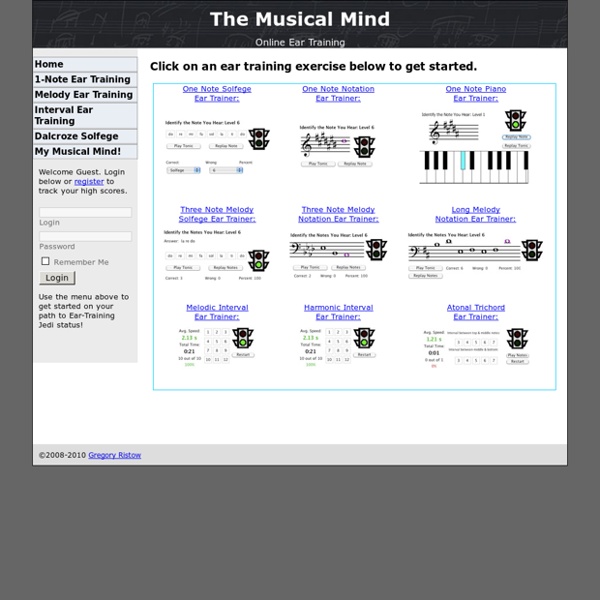



Free Music Theory Worksheets! Material on this page is free.NEW! you can now consult an index of terms used in these worksheets.Also explore a page of worksheet extras: Worksheet Answers, Test Templates and Flash Presentations. Here are some testimonials from music teachers about these workbook chapters: I have been using your fantastic music theory sheets and PDF downloads to teach high school piano theory to 28 students per class, all of whom are at different levels of study and accomplishment. Your method is comprehensive and easily accessible to students of all ages. Scales and emotions See also a post about making chords from scales. So maybe you want to write a song or an instrumental in a particular mood or style, and you’re feeling overwhelmed by all the scales. Here’s a handy guide to the commonly used scales in Western pop, rock, jazz, blues and so on.
Developing a vivid aural imagination The extent to which your aural imagination is developed, largely determines: the quality of lines you play, how you play those lines (articulation, swing feel, inflection), and the sound you play with. Nothing has such an impact on your playing than your aural imagination. If there were a secret to improvising, developing your aural imagination would be it. Ok, ok. I didn’t say oral imagination. You’ll have to go to the other 98% of the internet for that. Ear training Functional pitch recognition[edit] Many musicians use functional pitch recognition in order to identify, understand, and appreciate the roles and meanings of pitches within a key. To this end, scale-degree numbers or movable-do solmization (do, re, mi, etc.) can be quite helpful. Using such systems, pitches with identical functions (the key note or tonic, for example) are associated with identical labels (1 or do, for example).
I analyzed the chords of 1300 popular songs for patterns. This is what I found. For many people, listening to music elicits such an emotional response that the idea of dredging it for statistics and structure can seem odd or even misguided. But knowing these patterns can give one a deeper more fundamental sense for how music works; for me this makes listening to music a lot more interesting. Of course, if you play an instrument or want to write songs, being aware of these things is obviously of great practical importance. In this article, we’ll look at the statistics gathered from 1300 choruses, verses, etc. of popular songs to discover the answer to a few basic questions.
Learning and Loving Music Theory Kelvin, You actually caught a mistake on the roman numerals! Thanks, I’ll have to fix that. The first and last chords of the progression are not 7th chords. Somehow I inadvertently typed “I7″ on the first chord of all the major keys. Jazz Ear Training - Master Your Intervals in 28 Days Being able to quickly hear, sing, and accurately identify intervals is essential to developing your improvisational ear. In this article, I’ve put together a plan for you to master your intervals in 28 days. For beginners, this will give you a much needed foundation. And for more advanced players, it will give you a chance to brush up on your intervals and fill in any gaps that might be there. The goal is to be so familiar with these sounds, that it requires very little effort to process them. You can never know this stuff too well!
Outline of basic music theory Professional music theory: an outline of basic music theory. Preface and Chapter 1 of the Outline of basic music theory – by Oscar van Dillen ©2011-2014 The beginner’s learning book can be found at Basic elements of music theory. Overview of chapters: Chapter 1: Introduction Chapter 2: Sound and hearing Chapter 3: Musical notation Chapter 4: Basic building blocks of melody and harmony Chapter 5: Consonance and dissonance Chapter 6: Circle of fifths and transposition Chapter 7: Concerning rhythm, melody, harmony and form Chapter 8: Further study Best Quotes of All Time It’s been three years since we shared our original list of some of the best quotes of all time, and we felt it was a good time for an update. We’ve added another 25 quotes for you. But these aren’t just any quotes.